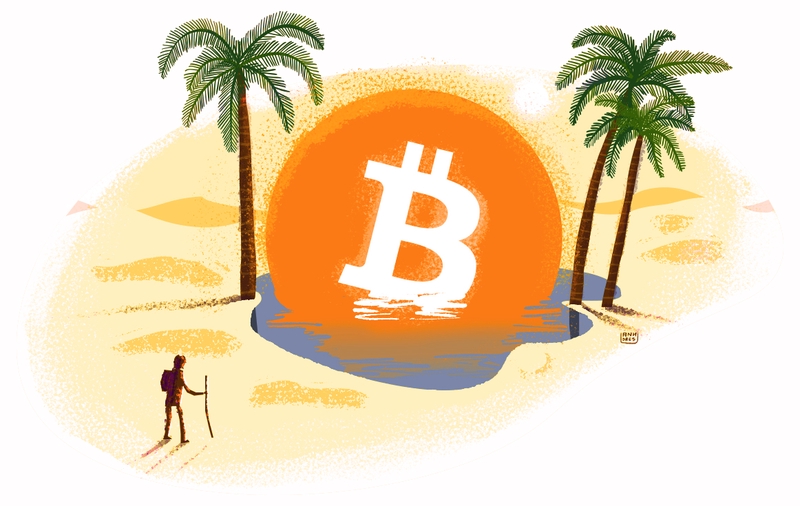A Beginner’s Guide to Getting Started with Bitcoin
Published at – 12 min read – 2354 words

A man looks for Bitcoin Oasis
If you have heard about blockchain or cryptocurrency, then the term that initially comes to mind is Bitcoin. Launched 12 years ago, it was the late 2017 bull run that created a media frenzy that propelled Bitcoin into the mainstream and our modern day lexicon.
Often labeled as the “original” cryptocurrency, Bitcoin has been the catalyst (directly and/or indirectly) behind many new innovations in the blockchain and digital asset space, most notably Ethereum and Monero. Shortly after the late 2017 bull run lost its steam, interest in these new technologies started to fade ― but here we are in 2021 with Bitcoin having risen like a phoenix from the ashes. As you would assume, an appetite for the blockchain and digital asset space has returned and now it is more important than ever that we understand what exactly is behind this unique asset, Bitcoin.
This article is meant to be a guide for individuals who are new to cryptocurrency and want to learn about Bitcoin, specifically its use case and the different ways to become involved in the broader blockchain and digital asset space. My goal is to educate you on the basics and make sure that you walk away with a newfound perspective and understanding of Bitcoin.
What is Bitcoin?
Bitcoin is a peer-to-peer version of electronic cash whose transactions are recorded in a public distributed ledger called a blockchain. In late October 2008, Satoshi Nakamoto (whose identity is still unknown) published a white paper titled Bitcoin: A Peer-to-Peer Electronic Cash System on bitcoin.org (registered in August 2008) and subsequently posted it to a cryptography mailing list. On January 3, 2009, the Bitcoin network was created when Satoshi Nakamoto mined the initial block of the chain, which is called the genesis block.
In essence, Bitcoin is a decentralized type of “digital money” that can be used by anyone around the world, at any time, and without restrictions or a central authority. Bitcoin is not backed by any bank or government and originally allowed users to freely send and/or spend it anywhere without trusting third parties.
At inception, the price of Bitcoin was approximately $0.01 and, as of today, the price has surpassed $40,000 per coin ― with many believing that it can grow exponentially higher to levels between $100,000 and $250,000 in the next year or so.

The transactions data are memorized through a chain-of-blocks
Given that Bitcoin exists and operates within the confounds of the Internet, all user balances are kept on an immutable and fully transparent blockchain. Put simply, each Bitcoin transaction is broadcasted to the Bitcoin network and grouped with several other transactions in the form of a block, which the network’s miners validate. Once the block is accepted, the transactions get recorded on the blockchain (which, as you may recall, is a public ledger). Whenever this process is successfully completed, the network distributes new Bitcoin to miners for each block that has been validated ― this is referred to as a block reward.
The peculiarity of the blockchain is its distribution and decentralized properties, as all the nodes share a valid copy of the public ledger. In the Bitcoin network, nodes play a very important role ― think of them as “protectors” who are constantly monitoring Bitcoin’s blockchain to distinguish legitimate Bitcoin transactions from illegitimate ones. The basic job of a node is to prevent attempts to double-spend Bitcoins that have already been spent elsewhere. In addition, the process of mining is essential to validating transactions, as it ensures the overall trustworthiness and security of the payment network.
Advantages and Limitations
Members of the cryptocurrency community, who range from the tech savvy to your average retail investor, have adopted various perspectives regarding the fundamental driver of Bitcoin’s value (both in financial and non-financial terms).
On one side, there are the Bitcoin Maximalists who believe that Bitcoin is the ultimate financial innovation and will assume a mainstream role in global society ― to maximalists, other cryptocurrencies and traditional financial instruments are inferior. On the other side, you have cryptocurrency enthusiasts who believe Bitcoin’s technology is outdated and that other cryptocurrencies, such as Ethereum, have more expansive utility.
These arguments and differences of opinion (as it relates to Bitcoin) can often become confusing, so let’s dig deeper into some of the most common discussion points with hopes that you can decipher for yourself.
Advantages
- A blockchain is managed autonomously using a peer-to-peer network and cannot be shut down ― the only way to stop it is through shutting down or banning Internet access. (Note: Even though a blockchain or Bitcoin cannot be shut down, some jurisdictions have imposed restrictions on citizens that limit or ban the holding or trading of Bitcoin and/or other cryptocurrencies.)
- There is no need to trust a third party. You are your own bank!
- Relatively quick and cheap transactions without intermediary fees (around 10 minutes on average per transaction), when compared to most leading cryptocurrencies.
- Increasing adoption by merchants and individuals across the globe.
- Largest market capitalization and name recognition, which will continue to promote its growth and (hopefully) price stability.
Limitations
- Lack of anonymity as transactions that take place in the Bitcoin network, along with many other leading cryptocurrencies, are fully transparent and can potentially be linked via chain analysis. In addition, strict AML/KYC regulations require many of the leading cryptocurrency trading exchanges to verify your most sensitive personal information.
- Slow and expensive transactions, when compared to lesser known cryptocurrencies that can be sent within seconds and at a fraction of the cost.
- Irreversible transactions. Once a transaction is sent, you cannot undo or cancel the transaction.
- Achievement of its status as a currency will be challenging due to its volatile nature (i.e. swings in price) and regulations.
- The core technology has some subtle limits that make Bitcoin outdated in comparison with other cryptocurrencies.
Along with Bitcoin Maximalists and cryptocurrency enthusiasts, you have many individuals who simply like to be long-term holders of Bitcoin (because they believe in the fundamentals and value proposition) and others who speculate on the short-term price (e.g. day traders).
Whatever side you are on, there is no question that Bitcoin has established itself as a serious contender in the financial world and is here to stay for the time being. There may be other alternatives, but the granddaddy of cryptocurrencies still has the spotlight!
How to Obtain Bitcoin from an Exchange
Now that you have an understanding of Bitcoin and its utility, you may be interested in purchasing some. If that is the case, you have come to the right place as buying it is now easier than ever due to the growing number of exchanges and companies making Bitcoin accessible to the masses.
Some of the most well-known exchanges that allow you to purchase Bitcoin and other cryptocurrencies are Coinbase, Gemini, Kraken, Binance, and Huobi. While all of these exchanges list Bitcoin, not all of them offer the same cryptocurrencies ― so, it is recommended to open accounts across a few exchanges to ensure that you are provided adequate exposure.
Once you have created an account on an exchange, you can transfer your local fiat money via ACH or bank wire to the exchange. From there, you can purchase Bitcoin or another cryptocurrency in exchange for your local fiat money. In addition, after purchasing Bitcoin, you can exchange it for another cryptocurrency that you might not be able to purchase with your local fiat money. While some exchanges offer credit card purchases of Bitcoin, please keep in mind that the fees associated with this transaction are typically very high.

You can exchange central currencies (EUR, USD) to BTC, but sacrificing privacy.
Using any of the exchanges listed above is the easiest and most convenient way to purchase Bitcoin, as the majority of the other cryptocurrency exchanges do not support fiat currencies. This being the case, you can only exchange other cryptocurrencies (like Ethereum or Monero) for Bitcoin. Cash App and PayPal, some of the largest financial technology companies, offer its users the ability to purchase Bitcoin. While this is extremely convenient for users of these platforms, the downside for PayPal (not Cash App) is that your Bitcoin must remain on its platform, so you cannot transfer or send it. Remember: Not your keys, not your coins.
If you are not keen on using any of the methods described above, Bitcoin ATMs are a great alternative. There are over 14,000 physical ATMs worldwide, most of which can be found in major cities at peculiar locations such as a shopping mall, burger restaurant, or a bar. All you need to do is deposit cash and enter your Bitcoin address. Once you have completed the transaction, the funds will be sent to you. This is a very simple process and typically does not require any identity verification, but beware of high fees!
Who Accepts Bitcoin?
Over the years, many individuals and businesses have begun accepting Bitcoin as a form of payment. From time to time, you might have noticed stickers on a shop’s window that says “Bitcoin accepted here.” As mentioned above, after the bull run of late 2017 died down, overall interest in cryptocurrencies (especially Bitcoin) amongst merchants began to wane. Today, Bitcoin and the broader digital asset space has bounced back from a pricing perspective and, with this, so has the interest amongst merchants who have triggered another wave of increased acceptance, most notably Tesla disclosing that it has invested approximately $1.5 billion into Bitcoin and that the company plans to accept Bitcoin as payment for its electric vehicles.
There have been a few prominent celebrities and sports figures who have let the public know that they either support or have begun accepting Bitcoin as payment, further increasing awareness. An example of this is Russell Okung, the offensive tackle for the Carolina Panthers, who recently became the first NFL player to be paid in Bitcoin. A tweet of his in December 2020 noted that he was paid in the cryptocurrency, making news headlines everywhere.
How to Store, Send, and Receive Bitcoin
It is imperative that owners of Bitcoin know how to keep it safe, as there are nefarious individuals or groups that actively attempt to take advantage of people’s naivety in regards to security. Another important point to stress is that most exchanges offer little to no insurance protection on your assets. Coinbase happens to offer insurance on your funds that you leave on its platform, similar to how a traditional bank would operate. If Coinbase were to get hacked and their systems were breached, your funds would be covered; however, if your account was hacked (i.e. someone acquired your login credentials and password), the insurance would not cover this type of breach, and your funds would be compromised.
Many exchanges are starting to keep the majority of their customers’ cryptocurrency in offline hardware wallets, otherwise known as “cold storage”. These are physical devices that have their own unique passcodes and security keys, intended to be unhackable as long as these keys are never revealed to anyone else. To keep the codes safe, they should be written down on paper and kept in a safe location. They should never be exposed to any type of camera, computer desktop, website, etc.

The mnemonic seed: only for your mind!
A seed is a list of words that store all the information needed to access and recover Bitcoin funds. Wallet software will typically generate a seed and instruct you to write it down on paper. If your computer breaks or your hard drive becomes corrupted, you can use the seed that was written down on a piece of paper to access and recover your funds on another device.
For individual use, the most popular hardware wallets are Ledger and Trezor. Both offer best-in-class products that help keep your Bitcoin and other cryptocurrencies safe. If you happen to choose any of these products, just remember to store your seed in a safe place that you will always remember. If you are unable to remember or locate your seed, your funds will be impossible to retrieve.
Sending and receiving Bitcoin is very straightforward and demonstrates the simplicity and efficiency of using cryptocurrency. Regardless of whether you are using an online exchange or a hardware wallet, you will always have your own personal Bitcoin wallet. In order to receive Bitcoin, go to your Bitcoin wallet and select “receive” or “deposit”.
Once complete, you will be given a long public address that you can copy and send to the person who will be sending you the payment. Once they enter your address, all they have to do is click “send” or “withdraw,” and the funds will be on their way. If you are sending Bitcoin to someone, the same holds true as before, except that you will need to request their long public address and enter those details before withdrawing from your wallet. Remember that when sending or receiving Bitcoin, you should usually wait around 10 minutes for the transaction to process. It can often take additional time to process, so do not panic if it exceeds the 10 minute average timeframe.
Bitcoin as a Mainstream Currency
Regardless of public sentiment, it is clear that Bitcoin has gained tremendous traction since its beginnings in 2009. In 2020 and now into 2021, we are seeing more retail investors and institutions come on board and mainstream interest is starting to kick in again ― as Bitcoin hit its previous all time high in December 2020 and continues to set new records early into 2021. So what’s next for Bitcoin? Nobody knows for sure, but many experts see amazing potential in the near and long-term future.
What we have reviewed today has hopefully piqued your interest in Bitcoin and cryptocurrencies. With this newfound perspective and understanding of Bitcoin, specifically its fundamentals and utility, I hope that this overview serves as a helpful guide as you venture into the world of the digital asset space. So, give Bitcoin and other cryptocurrencies a try and join in on the greatest financial innovation of the Fourth Industrial Revolution!

